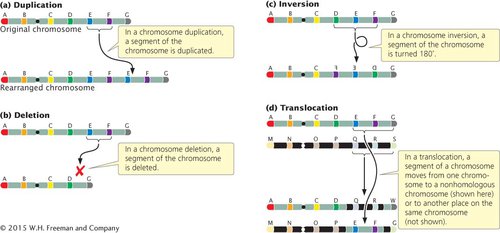Chromosome rearrangements are mutations that change the structure of individual chromosomes. The four basic types of rearrangements are duplications, deletions, inversions, and translocations (Figure 6.4). Many of these chromosome rearrangements originate when double-strand breaks occur in the DNA molecules found within a chromosome. Double-strand breaks in DNA often cause cell death, so organisms have evolved elaborate mechanisms to repair breaks by connecting the broken ends of DNA. If the two broken ends are rejoined correctly, the original chromosome is restored, and no chromosome rearrangement results. Sometimes the wrong ends are connected, however, leading to a chromosome rearrangement. Chromosome rearrangements can also arise through errors in crossing over or when crossing over occurs between repeated DNA sequences.

Figure 6.4: The four basic types of chromosome rearrangements are duplications, deletions, inversions, and translocations.
